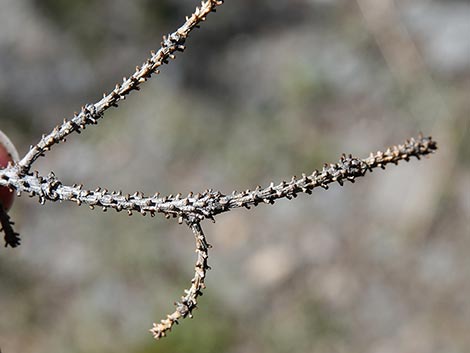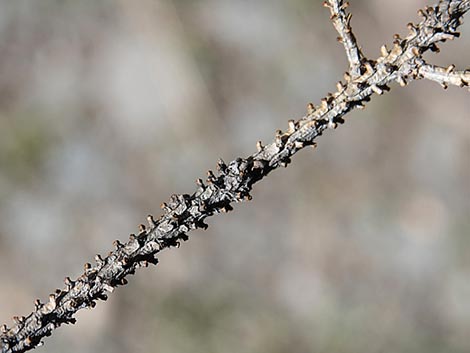
Evergreen Trees (Conifers), Vegetation Around Las Vegas
 |
General: Blue Spruce (Picea pungens) is a tall (to 165 ft), sharply conical, coniferous (cone-bearing) tree. Twigs have persistent, peg-like "leaf" petioles, and the twigs and leaf bases are not hairy. The needles are squarish, radiate out from the twigs, are stiff, and have a sharply pointed tip. The seed cones are 2-1/2 to 4-1/2 inches long, papery, cylindrical, and tend to hang down from the branches. Individual cone scales are diamond-shaped and extend well (8-10 mm) beyond seed impression. Blue Spruce do not occur naturally in Nevada. Instead, look for this species in the Rocky Mountains in places such as Zion, Cedar Breaks, and Capitol Reef National Parks where Blue Spruce is a common component of the montane vegetation in the Canadian (Pine-Fir Forest) life zone. Family: Pine (Pinaceae). Other Names: Colorado blue spruce. |
 Twigs with persistent "leaf" petioles |
Plant Form: Tall conifer, sharply conical with pointed crown. Height: To about 165 feet. Trunk: To 5-ft diameter. Bark: Gray-brown. Branches: Branches slightly to strongly drooping. Twigs stout, yellow-brown, usually glabrous. Needles: 0.5 to 1.2 inches, square in cross section, rigid, blue-green, bearing stomates on all surfaces, sharp-pointed tip. |
 |
Cones: Light-green aging to tan, 2-1/2 to 4-1/2 inches long. Cone scales elliptic to diamond-shaped, and the outer edge is irregularly notched or toothed. The apex of the cone scale extends 8-10mm beyond seed impression. Cones tend to remain on the tree after seed maturity. Seeds: Habitat: Middle-elevation mountain slopes and valleys. Elevation: 6,000 to 10,000 feet. Distribution: Idaho and Wyoming to Arizona and New Mexico. In northern Nevada, we have Engelmann Spruce (Picea engelmannii). Comments: This species is often used as an ornamental tree. Dive into the difference between Blue Spruce and Engelmann Spruce here. |
 |
 |
 |
 |
 |
 |
 Needles radiate from the stems |
 Needles square in cross section, tip with a spine |
 Smaller twigs have persistent, peg-like "leaf" petioles |
 Smaller twigs have persistent, peg-like "leaf" petioles |
 Smaller twigs have persistent, peg-like "leaf" petioles |
 Twigs with persistent "leaf" petioles |
 Maturing cones mostly high in the tree |
 New (green) and old (brown) cones |
 Cones usually hang down from twigs and branches |
 Cone scales with notched ends |
 Cone scales papery |
 Cone scales diamond-shaped or elliptic |
Note: All distances, elevations, and other facts are approximate. Names generally follow the USDA database.
![]() ; Last updated 250721
; Last updated 250721
| All Conifers | Plant Species Index | Glossary | Copyright, Conditions, Disclaimer | Home |